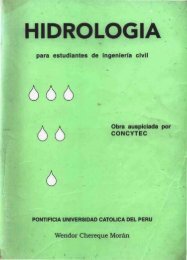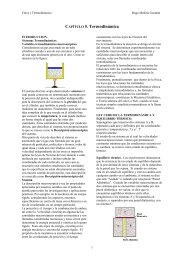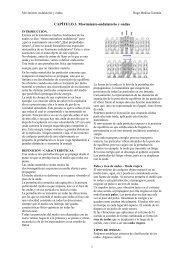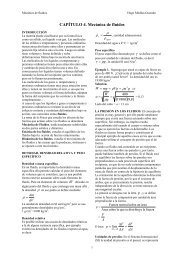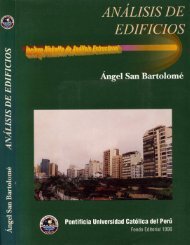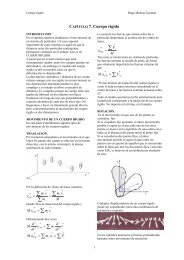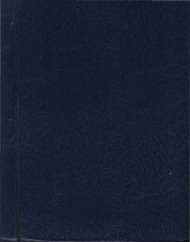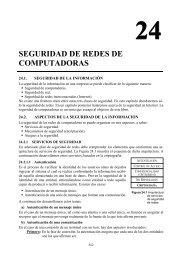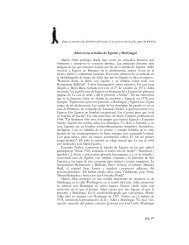CAPÍTULO 4. Dinámica de una partícula - Biblioteca
CAPÍTULO 4. Dinámica de una partícula - Biblioteca
CAPÍTULO 4. Dinámica de una partícula - Biblioteca
You also want an ePaper? Increase the reach of your titles
YUMPU automatically turns print PDFs into web optimized ePapers that Google loves.
<strong>Dinámica</strong> <strong>de</strong> <strong>una</strong> <strong>partícula</strong> Hugo Medina Guzmán<br />
Solución.<br />
La figura muestra el D.C.L. <strong>de</strong> la masa m 1 .<br />
Consi<strong>de</strong>remos que el movimiento es <strong>de</strong> izquierda a<br />
<strong>de</strong>recha con aceleración a<br />
∑ y<br />
∑ x<br />
F :<br />
0 º 30 cos<br />
N − m g =<br />
1<br />
1<br />
F :<br />
a m g m F T − f 1 − 1 sen 30º<br />
= 1<br />
De estas ecuaciones<br />
N 1 = m1g<br />
cos30º<br />
= 20 × 10×<br />
3<br />
= 173 N<br />
2<br />
Ff = μ N = 0,<br />
3×<br />
173 = 51,<br />
9 N<br />
1<br />
1<br />
1<br />
2<br />
y T − 51 , 9 − 20×<br />
10×<br />
= 20a<br />
⇒ T = 151 , 9 + 20a<br />
La figura muestra D.C.L. <strong>de</strong> la masa m 2 .<br />
∑ y<br />
∑ x<br />
F :<br />
0 º 60 cos<br />
N − m g =<br />
2<br />
2<br />
F :<br />
a m T F g m2 sen 60º<br />
− f 2 − = 2<br />
De estas ecuaciones<br />
1<br />
N 2 = m2<br />
g cos60º<br />
= 20 × 10×<br />
= 150 N<br />
2<br />
Ff = μ N = 0,<br />
3×<br />
150 = 45 N<br />
2<br />
3<br />
2<br />
⇒ T = 214, 5 − 30a<br />
2<br />
y 30 × 10×<br />
− 45 − T = 30a<br />
Igualando los valores <strong>de</strong> T:<br />
151, 9 + 20a<br />
= 214,<br />
5 − 30a<br />
⇒<br />
Como v v + at ,<br />
= 0<br />
Siendo v0 = 0 ⇒<br />
Para = 4 s<br />
t ⇒<br />
v =<br />
1, 25t<br />
2<br />
v = 1 , 25×<br />
4 =<br />
m<br />
a = 1,<br />
25 2<br />
s<br />
m<br />
5<br />
s<br />
17<br />
Ejemplo 23. En <strong>una</strong> mesa un plato <strong>de</strong>scansa sobre el<br />
mantel, cuyo centro está a 0,25m <strong>de</strong>l bor<strong>de</strong> <strong>de</strong> la<br />
mesa. El mantel se jala súbitamente en forma<br />
horizontal con <strong>una</strong> aceleración constante <strong>de</strong> 10 m/s 2 .<br />
El coeficiente <strong>de</strong> fricción cinético entre el mantel y el<br />
plato es μ k = 0,<br />
75 . Asumiendo que el mantel llega<br />
justo al bor<strong>de</strong> <strong>de</strong> la mesa.<br />
Cuando el extremo <strong>de</strong>l mantel pasa bajo el centro <strong>de</strong>l<br />
plato, encontrar:<br />
a) La aceleración <strong>de</strong>l plato<br />
b) La velocidad <strong>de</strong>! plato<br />
c) La distancia <strong>de</strong>l plato al bor<strong>de</strong> <strong>de</strong> la mesa.<br />
Solución.<br />
a) Aplicando la segunda ley <strong>de</strong> Newton para el plato,<br />
la masa <strong>de</strong>l plato es m y su aceleración a p .<br />
∑ V<br />
F = 0 ⇒ 0 = − N mg<br />
H p ma ∑ F = ⇒ F f = ma p<br />
De aquí obtenemos:<br />
N = mg y μ k mg = ma p<br />
De don<strong>de</strong>:<br />
μ g<br />
a p = k = 0,75 x 9,8 = 7,35 m/s 2<br />
El plato resbala ya que a p es menor que 10 m/s 2<br />
b) En el instante en que el extremo <strong>de</strong>l mantel<br />
coinci<strong>de</strong> con el centro <strong>de</strong>l plato están a la misma<br />
distancia <strong>de</strong>l bor<strong>de</strong> <strong>de</strong> la mesa<br />
x = x<br />
p<br />
m<br />
1<br />
2<br />
1 2 1<br />
= a t = 10t<br />
2 2<br />
1<br />
2<br />
2<br />
2<br />
x p = 0, 25 + a pt<br />
= 0,<br />
25 + 7,<br />
35t<br />
xm m<br />
Igualando<br />
1<br />
2<br />
1<br />
2<br />
2<br />
2<br />
0, 25 + 7,<br />
35t<br />
= 10t<br />
Resolviendo:<br />
t = 0,<br />
58 s y<br />
2



